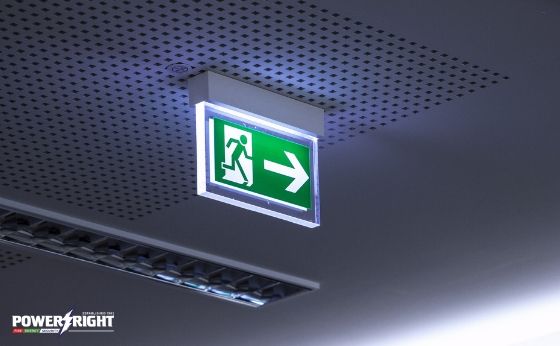Emergency lighting is a necessity for any building. It’s a must-have due to the simple fact that it is designed and developed to be of use during an emergency. Emergency lighting, as the name suggests, lights up during an emergency. It guides people towards the nearest exit during a power failure. Hence, these emergency exit lights are required in all kinds of commercial buildings, from offices to schools. Since they are highly important, there are some things you need to know about them before you install them in your building.
Types of Emergency Exit Lights
There are two main types of emergency lighting, namely:
Self-Contained Emergency Lighting
Also known as single-point lighting, this type of emergency exit light runs on its own particular power source. It essentially has its own battery. It offers a number of key advantages that include:
- Fast and cheap installation of the lighting system as there is no requirement for additional power cables to be installed.
- The wiring material in self-contained emergency lighting can be quite standard. It contrasts with the regular fire resistant cables that are required for central battery source emergency lighting systems.
- A simple burn through the main cable is all that is required for this emergency exit light to turn on.
- Self-contained emergency lights have low maintenance costs. They just need to be tested from time to time and require general cleaning.
- The hardware equipment costs are low and do not require any extra ventilation or extended wiring.
- It offers more system integrity since every luminaire installed is independent.
- The entire system can easily grow just with the addition of more luminaires.
- There is no need for the installation of a sub-circuit monitoring system.
On the other hand, some of its disadvantages include:
- Self-contained emergency lighting systems are prone to environmental conditions. Their batteries are affected by extremities in temperature.
- Battery life is short with just a span of 2 to 4 years.
- The testing procedure is extensive as each luminaire has to be tested independently.
Central Battery Source
This type of maintained emergency lighting runs on a central battery source that supplies power all around the room with cables. Its advantages include:
- Maintenance and testing of routes is easier since there is just one location to check from.
- Battery life is extensive, going from 5 to 25 years depending on the type.
- It is stable when faced with environmental changes. Can operate at both low and high temperatures.
- Large batteries provide cheaper power, making it cost-effective in the long run.
The disadvantages include:
- Initial investment costs are high.
- Cost of installation is high as well since an extensive cabling system is required.
- Lack of proper system integrity since damage to the central battery source will blow out the entire system.
- The maintained emergency lighting will require a large “battery room” for housing the batteries and circuits. Expensive ventilation will be a necessity.
- Failure in the localised mains on the premises will not be enough to trigger the emergency lighting system.
Emergency lighting is an essential part of any commercial building. They have to be situated in a sequential manner, with one light following another, in order to guide people to safety. Whether you get the self-contained emergency lighting or the maintained emergency light system is dependent on your requirements. However, what is true for both is their importance as emergency exit lights for commercial buildings.
